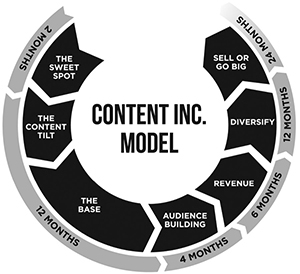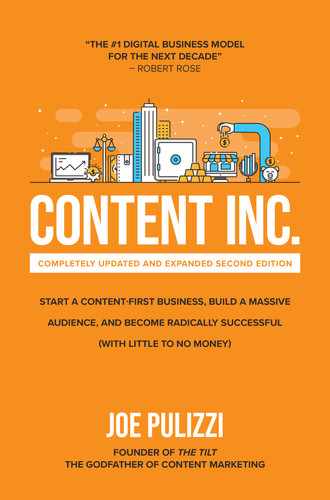![]()
CHAPTER 23
![]()
PUTTING IT ALL TOGETHER
Never look back unless you are planning to go that way.
There is no definitive timetable for success. I wish there were.
I started my Content Inc. journey in April 2007 and almost quit in September 2009 because I felt I did not have the patience to continue. Luckily, I stayed with it, promising my wife I would give it a few more months. By May 2010, the audience numbers started to flourish, and we were able to secure sponsorships to keep the company going. In 2011 we hit a million dollars in revenue. The next three years we hit the Inc. 500 list of fastest-growing private companies. In 2016, we sold for nearly $30 million.
We hit the $5 million valuation mark in the year 2012, five years after we started. It’s not rocket science, but that seems to be a good benchmark. Most of the Content Inc. cases interviewed for this book are valued between $2 million and $10 million after five years.
THE CONTENT INC. MODEL TIMETABLE
In looking at hundreds of Content Inc. examples over the past decade, the following chart becomes useful in gauging how long the process should take.

Let’s examine each step in more detail.
THE SWEET SPOT AND THE CONTENT TILT: 2 MONTHS
It takes a few months to find your sweet spot and begin testing your content tilt. For CMI, the tilt of content marketing (as a term) was immediate. It took an adjustment a few years later, a focus on enterprise marketing professionals, to push the model into high gear.
THE BASE: 12 MONTHS
It is acceptable to test out platforms in your first couple of months. By at least the 6-month mark, you should decide on your core platform. Another 6 months and you should have your content plan, your frequency, and your subscription options set for maximum audience building.
AUDIENCE BUILDING: 4 MONTHS
Once the base is working, everything should be focused on building opt-in subscribers. Have an email offering, especially if your base is built on a social media platform. Though the base may be working, you probably do not have a large or focused enough audience to drive revenue yet.
REVENUE: 6 MONTHS
Although you will want to drive revenue as soon as possible, revenue options seem to present themselves at about the 18-month mark. Take these months to identify the best revenue option, and stick with it for a few months before seeking out other revenue options. Focus is key.
DIVERSIFY: 12 MONTHS
Now that you have one critical platform working, you need to “derisk” the model by creating additional extensions. These can be organic launches or content asset acquisitions. Prime diversification time occurs around two to three years.
SELL OR GO BIG: 24 MONTHS
The timetable depends on your overall goals and exit strategy. At minimum, if you have not already done so, you need to develop a written exit strategy once you are deep into the diversification stage. If you’ve gone this far, you most likely have a truly valuable business and one that will either be precious to someone else or print money for you as a lifestyle business for years to come.
ONE WORD: PATIENCE
Be patient.
There are only nine months between when I believed I was a complete failure and when I started something that promised success. As I think back, it would have been so easy to give up and go find a “real” job. I’m so glad I didn’t. My Content Inc. outcome was the stuff dreams are made of. If I had not been patient, none of it would have happened.
There is no doubt in my mind that this is the absolute best way to launch a business. Yes, it is different. Some may say it is strange, but it is a better strategy than just hoping a new product idea will take hold. Be like David, who fought the urge to fight just like everyone else had against Goliath (and lost). Take a different route and put the odds in your favor.
GETTING STUCK
As you progress through this model, there will be moments where you feel the model is not working quite to your expectations. That makes sense. Content Inc., as a way of launching a business, is a new muscle for most people. We have been used to communicating through mass media for so many years, and now we are trying to figure out how to deliver value to our customers outside of our products and services.
If you are struggling with your program, come back and review this chapter. You may be struggling for any of these reasons:
• Selfish content marketing. Create content that solves customers’ pain points or touches on aspirations. Stop talking about your products and services so much. If you do, make it about your customers.
• You stop. The biggest reason the model fails is because you either stop or aren’t consistent. Remember, the content you deliver is like a promise to your customers. The biggest reason the examples in this book succeeded was because the people never stopped producing amazing and compelling content.
• Activity instead of audience. Having people share and engage with your content here and there does not mean much unless you are building an audience. One of the biggest mistakes Content Inc. models make is not planning, in advance, to acquire an audience through content creation and distribution.
• No promotion. Have you spent too much of your time and resources on content, and not enough on marketing the content?
• No point of view. To position yourself as an expert in your industry, you need a point of view. Take a stance. Walking the fence is boring and, more importantly, usually doesn’t work.
• No process. I see it every day. Scenario: A marketing campaign means placing ads. Then someone asks about the blog or white paper. People scurry about, and someone runs out to get the content. Plan up front to create, repurpose, and distribute content.
• No call to action. Each piece of content should have a call to action or behavior you’d like to see. What would happen if you asked “why?” to each piece of content you create? By doing this, you will be compelled to either know the call to action or kill the content for lack of purpose.
• Forgetting employees. Employee expertise is the most underused content asset. Your employees give your brand life. Leverage them in the creation and distribution process. Start with the 5 percent that get it. Show success stories and move on to the rest of your employee base.
• One word: editing. Editing may be the most underrated piece of the content process. Sometimes entrepreneurs don’t understand that the first draft of a piece of content is called a good start. Enter the editor. Get one or hire one.
What’s holding you back from your Content Inc. model?
ARE YOU RISKING ENOUGH?
In preparation for this version of Content Inc., I listened to an interview between Joe Rogan and Colin O’Brady.
Colin is a professional endurance athlete, which means he does things that most people don’t, like climb Mount Everest or walk across Antarctica. He mentioned an idea that fascinated me.
He said that most people live their lives on a scale between a 4 and a 6. So on a 10-point scale, 1 being the worst possible day and 10 being the best possible day, Colin believes that most people never get too high or too low.
People just live routine days doing routine things. But think about it. A rating of 4 isn’t horrible for your worst possible day. And while 6 isn’t great, it’s not terrible.
Colin disagrees. He believes that the majority of people aren’t taking enough risks. They aren’t, as he puts it, chasing their Mount Everest. When you chase big, risky ideas and goals, Colin believes, you rarely fall into the middle of the scale. You are often an 8, 9, or 10, or if you took a big risk and failed, you are a 1 or a 2.
Is he right? Frankly, I don’t know—but it did get me asking myself if I take enough risks.
I’m a risk taker at heart. I started a business when I probably shouldn’t have and wrote a novel when I didn’t have a clue how to write one. I love challenges like that. To me, these were big ideas. But now I’m starting to question whether I’m taking enough risks.
I see a lot of people around me waiting. Waiting for retirement. Waiting for the next holiday. Waiting for a promotion. In all these cases, are they really making a positive impact on the world, living between a 4 and a 6? That’s not for me to answer, but it does get me thinking.
Maybe I’m not doing enough. Maybe I could be doing more. Am I afraid to take certain risks? Am I so afraid of a 1 that I’m unwilling to go for a 10?
Not five minutes after I listened to Colin make his little speech with Joe Rogan, I accidentally pulled this quote from my cluttered desk. It’s by Calvin Coolidge, thirtieth president of the United States:
Nothing in the world can take the place of persistence. Talent will not; nothing is more common than unsuccessful men with talent. Genius will not; unrewarded genius is almost a proverb. Education will not; the world is full of educated derelicts. Persistence and determination alone are omnipotent. The slogan “Press On” has solved and always will solve the problems of the human race.
I love this quote because it gives you no excuses.
What’s holding you back from making all your dreams come true?
Everything is impossible until it happens.
MOVING FORWARD
Yes, there will be challenges. There will be times you are not sure you are on the right path. That is natural for any entrepreneur or small business owner. But here’s the truth: Until now, it was cost prohibitive for entrepreneurs to build a loyal audience. Until now, the communication channels were not available. Until now, the audience wasn’t willing to connect.
Until now.
By following the Content Inc. method in this book, you have an opportunity to make a difference in your life, your family, your career path, and the world. I hope that you seize that opportunity today and never look back.
